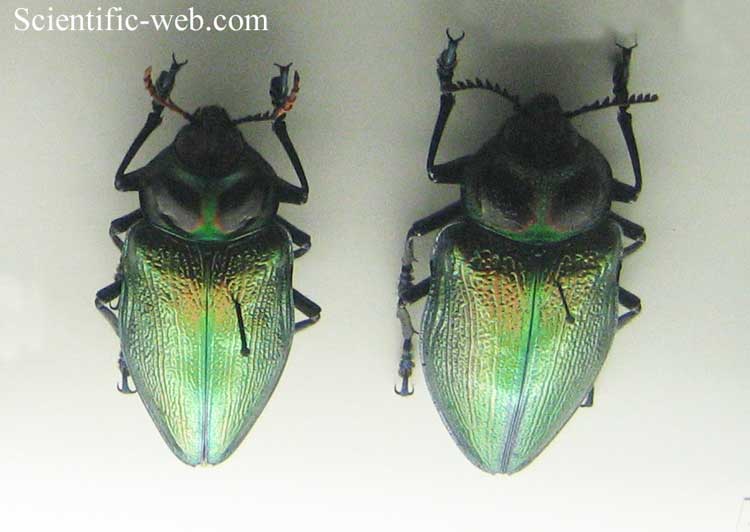
Euchroma giganteum, Photo: Michael Lahanas
Superregnum: Eukaryota
Cladus: Unikonta
Cladus: Opisthokonta
Cladus: Holozoa
Regnum: Animalia
Subregnum: Eumetazoa
Cladus: Bilateria
Cladus: Nephrozoa
Cladus: Protostomia
Cladus: Ecdysozoa
Cladus: Panarthropoda
Phylum: Arthropoda
Subphylum: Crustacea
Superclassis: Allotriocarida
Classis: Hexapoda
Classis: Insecta
Cladus: Dicondylia
Subclassis: Pterygota
Cladus: Metapterygota
Infraclassis: Neoptera
Cladus: Eumetabola
Cladus: Endopterygota
Superordo: Coleopterida
Ordo: Coleoptera
Subordo: Polyphaga
Infraordo: Elateriformia
Superfamilia: Buprestoidea
Familia: Buprestidae
Subfamilia: Chrysochroinae
Tribus: Paraleptodemini
Subtribus: Euchromatina
Genus: Euchroma
Species: Euchroma giganteum
Subspecies: E. g. giganteum – E. g. goliath – E. g. harperi – E. g. inca – E. g. peruanum
Name
Euchroma giganteum (Linnaeus, 1758)
Synonyms
Basionym: Buprestis gigantea Linnaeus, 1758
References
Primary references
Linnaeus, C. 1758. Systema Naturae per regna tria naturæ, secundum classes, ordines, genera, species, cum characteribus, differentiis, synonymis, locis, Tomus I. Editio decima, reformata. Holmiæ: impensis direct. Laurentii Salvii. i–ii, 1–824 pp DOI: 10.5962/bhl.title.542: 408. Reference page.
Links
Genus Euchroma. coleopsoc.org
ZooBank: C53A528B-A889-4E72-9EA2-309E286DE778
Euchroma giganteum, the Metallic Wood Boring Beetle or Giant Metallic Ceiba Borer, is a species of beetle in the family Buprestidae, the only species in the genus Euchroma.[2]
Subspecies
Euchroma giganteum giganteum (Linnaeus, 1758)
Euchroma giganteum goliath (Laporte & Gory, 1836)
Euchroma giganteum harperi Sharp, 1881
Euchroma giganteum incum Obenberger, 1928
Euchroma giganteum peruanum Obenberger, 1928
[3][4][5]
Description
Euchroma giganteum is one of the largest of the buprestid beetles (hence the Latin name "giganteum" of the species), reaching a length of about 50–80 millimetres (2.0–3.1 in).[6]
Catoxantha and Megaloxantha are among the few other members of the family that reach a comparable size.[7]
The body of E. giganteum is robust and elongated and the elytra have a wrinkled surface and a metallic green colour with reddish or purplish tinges. The pronotum has a dark spot on each side.[6][4] The larvae reach a length of about 12–15 centimetres (4.7–5.9 in).[6] The elytra of newly emerged adults have a coating of a yellowish, waxy powder. As the beetle ages this powder wear off.[4]
Behavior
The males apparently attract the females by a clicking sound produced by the elytra.[6] This species usually mates in August.[6][8] The larvae are miners of fallen timber, while adults are usually found walking around on the trunks of trees.
Diet
Larvae feed on decaying timber, especially of the Bombacaceae family (kapok or ceiba trees, mainly Ceiba pentandra , Bombacopsis spp., Ochroma spp. and Pseudobombax spp.), but also of Araucaria angustifolia and Ficus species.[6]
Distribution and habitat
This species is native to Central and South America (Mexico, Panama, Ecuador, Cuba, Jamaica, Peru, Brazil, Colombia, Argentina y Venezuela (Guarenas-Naranjal)).[6] It lives in warm Amazon regions up to elevations of 1,200 metres (3,900 ft) above sea level.[6][4]
References
Zoobank
Bellamy, C. L. (2010). "Genus Euchroma". A Checklist of World Buprestoidea. Retrieved 21 Jun 2011.
Biolib
Hogue, C.L. (1993) Latin American Insects and Entomology. University of California Press, Berkeley and Los Angeles, California
Moura, R.C., Melo, N.F. and Souza, M.J. (2008) High levels of chromosomal differentiation in Euchroma gigantea L. 1735 (Coleoptera, Buprestidae). Genetics and Molecular Biology, 31(2): 431-437
"Euchroma gigantea at Arkive.org". Archived from the original on 2013-04-14. Retrieved 2011-12-12.
Entomologi Italiani
M. Louise Nichols - - The Spermatogenesis of Euchroma Gigantea
Retrieved from "http://en.wikipedia.org/"
All text is available under the terms of the GNU Free Documentation License

